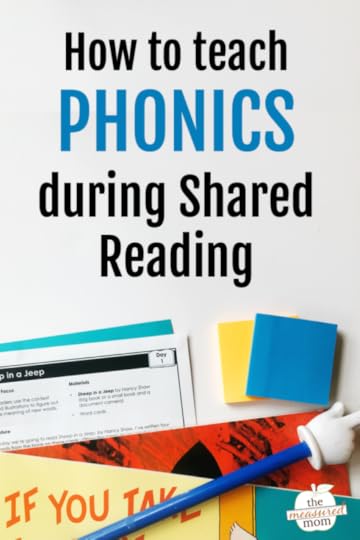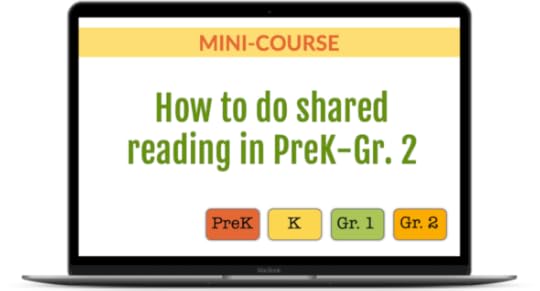How to teach phonics during shared reading
Shared reading is a wonderful vehicle for teaching all kinds of reading skills and strategies … including phonics. In today’s post I’m sharing a simple process for teaching phonics skills and decoding strategies during shared reading.

Have you been following along in my series about shared reading?
In Week One, I explained what shared reading is.
Last week, I gave you an editable shared reading lesson template .
Today I’d like to show you how you can use your shared reading lessons to teach phonics patterns, using a simple 3-step process.
How to use shared reading to teach phonics patterns
Step 1 – Identify phonics skills/patterns that you can pull from the text.
Read through the text, and see if you find any phonics patterns that are repeated at least 2-3 times and��that your students would benefit from learning.
Examples:
CVC words
CVVC words (words with ee, ea, oo, etc.)
Word endings (s, -es, ing, etc.)
Words with prefixes or suffixes
Other multi-syllable words
Step 2 – Choose a day to focus on that phonics pattern.
Remember that we should do shared reading 3-5 days a week.
I usually prefer to focus on the phonics skill toward the beginning of the week (usually on the second lesson). My reason for this is is that children are still learning the text at the beginning of the week and are likely to be doing more word-solving than they will do at the end of the week. (I like to save fluency and more advanced comprehension for the end.)
Step 3 – Decide how you will focus on the phonics pattern, both in and out of the text.
My preference is to highlight that phonics pattern while reading, but then to��take it out of the text for isolated practice. Then return back to the text to read words with that pattern in context.
For example, you can use��Sheep in a Jeep to teach learners that��ee and��ea make the long e sound.
Notice and highlight words with that pattern in the text. You can use highlighter tape or Wikki Stix.
Then take the skill out of the text by helping students read cards with words that have those patterns. Another option is to give students word cards to read and sort (perhaps contrasting CVC short e words and CVVC ee�� or ea words).
Finally, read the text again, encouraging students to remember to read��ee and��ea words with a long e sound.
How to use shared reading to teach decoding skills
We can also use our phonics skills to decode words. Use this 3-step process for teaching decoding during shared reading.
Step 1 – Identify words that will help you teach a particular decoding skill.
This is going to vary depending on the ability of your learners and the level of book you are using. For example, we want our youngest readers (reading at levels A-C, for example) to use the first letter of a word to help them solve it. But as students build up their phonics knowledge, we leave this skill behind.
Here are some decoding skills you might teach (not a full list!):
Use the first letter of the word and the picture to help you figure out a tricky word.
Back up and reread a tricky word when your reading doesn’t make sense.
Check the first and last letters of a tricky word.
Blend the sounds in a short word.
Look for chunks you know in a tricky word.
Take a big word apart into chunks; read each chunk and put them together to make the word.
If you get stuck, skip a tricky word and read to the end of the sentence. Then go back and try again.
Cover the word ending; read the word without the ending, and then add it back on.
Step 2 – Choose a day to focus on that decoding skill.
I would teach that decoding skill on the first or second day. You want to teach it when the text is fresh so that students actually have to decode the word (instead of remembering what it was from a previous day’s reading).
Step 3 – Decide how to teach the decoding skill.��
You are going to want to read the text together at a slow enough pace that you are not jumping ahead of your students and solving all the tricky words for them.
One way to slow yourself down is to cover those tricky words with sticky notes until you get to them. Then reveal the words as you reach them, and teach your students a particular decoding skill as you solve it together.
You might also take the decoding skill out of the text by putting words (or sentences, depending on the skill) on slips of paper. Guide students as they read the tricky words in pairs. Then return to the text one more time before the lesson is over.
Stay tuned for more about shared reading!
<
��Part 1 ��Part 2 ��Part 3 ��Coming January 28 ��Coming February 4
And check out the mini-course
in The Measured Mom Plus!

Log in to your account at The Measured Mom Plus and view my mini-course about shared reading.
Learn exactly what to teach during shared reading lessons.
Find out how to keep the same text from getting boring.
Get 5-day shared reading lesson plans for multiple books and grade levels!
© 2020, Anna G. All rights reserved.
The post How to teach phonics during shared reading appeared first on The Measured Mom.
Anna Geiger's Blog
- Anna Geiger's profile
- 1 follower



